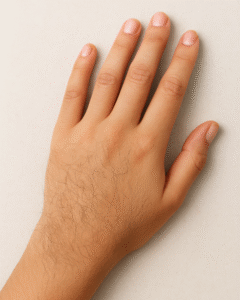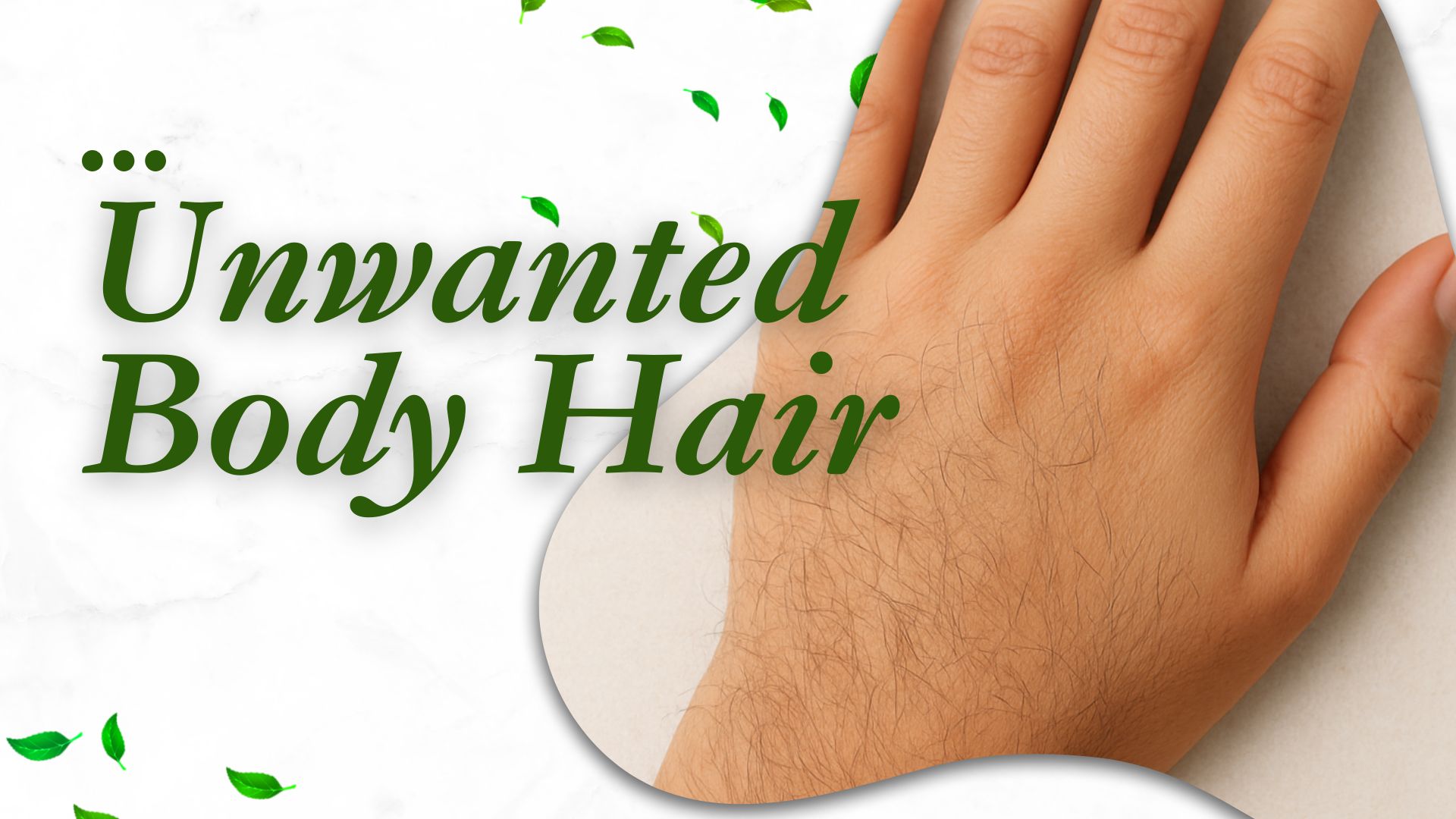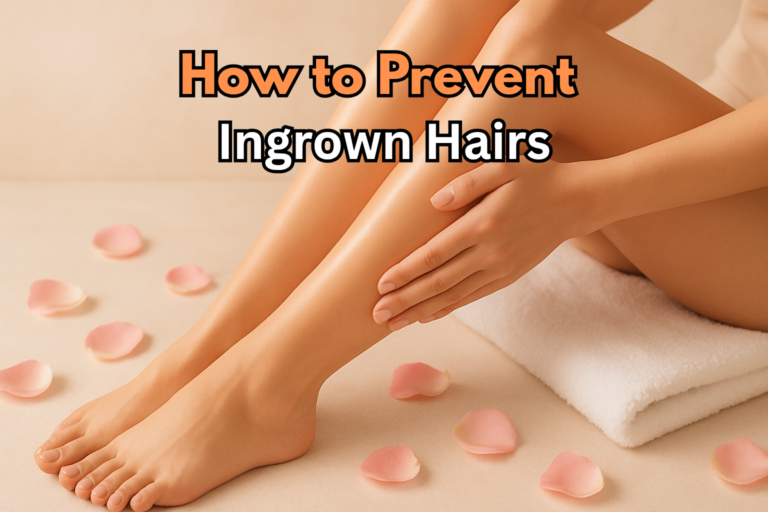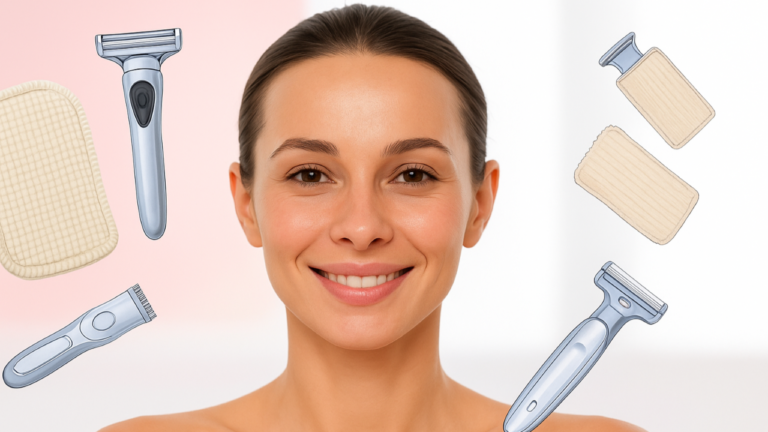Everybody has body hair. It’s completely normal. However, unwanted body hair causes annoyance, discomfort, or self-consciousness for a lot of people, both men and women.
In this article, we’ll explain why unwanted body hair appears, when it could signal an underlying medical issue and how to manage or remove it safely and effectively.

What do we mean by “unwanted body hair”?
“Unwanted body hair” refers to hair growth in areas, quantities or styles that an individual deems undesirable. Thick dark hairs on the face, neck, chest, back, abdomen, and other places may be an example of this.
In women when hairs appear in a pattern more typical of male hair growth (chin, upper lip, chest) the term Hirsutism often applies.
For men “unwanted hair” may still simply refer to excessive or dense hair where one might prefer smoother skin (for example on the back or chest). The key point is that this hair growth is excessive relative to a person’s expectations or norms.
Why does unwanted body hair appear?
Understanding why excess hair appears helps decide whether the issue is purely cosmetic (and thus treated by hair removal) or whether it points to a medical condition that needs diagnosis and treatment.
1. Hormonal imbalances
One of the main drivers of unwanted body hair- especially in women- is an excess of androgens (male-hormone type substances, e.g. testosterone) or increased sensitivity of hair follicles to androgens.
- For women, conditions like Polycystic Ovary Syndrome (PCOS) are among the most common causes of hirsutism. In fact > 70% of hirsutism cases are linked to PCOS.
- Other endocrine disorders such as Congenital Adrenal Hyperplasia, Hyperprolactinemia, thyroid disorders and androgen-secreting tumours may also be involved.
- Some medications (for example, steroids, certain hormone treatments, anti-seizure or immunosuppressive drugs) can trigger unwanted hair growth.
2. Genetics and ethnicity
Hair growth patterns, thickness, colour and distribution are strongly influenced by genetic background. Some people simply have a predisposition to denser or darker body hair. For example, mild idiopathic hirsutism (no clearly identified cause) is thought to be genetic in many cases.
3. Changes linked with life-stages or hormones
- Pregnancy and menopause bring hormonal fluctuations (especially in women) that can trigger increased hair growth in unexpected areas.
- Puberty is a naturally high-androgen state and so hair growth increases in both sexes.
- Hormonal therapy (such as testosterone therapy in transgender men, or anabolic steroid use) may cause hair growth.
4. Other medical conditions
Besides the endocrine causes mentioned, hair growth might increase due to conditions like Cushing’s Syndrome, Acromegaly, or even localised skin disorders.
5. Normal variation
It’s essential to recognise that “some hair” is absolutely normal. Determining when hair growth is “excessive” can depend on cultural norms, personal expectations, and ethnic background. For instance, the Ferriman–Gallwey score is a clinical tool used to measure hirsutism in women—but cut-off values differ by ethnicity.
How unwanted hair manifests– symptoms & signs
When unwanted hair growth is significant, here are some key signs to watch:
- In women: thick dark hair growth on the upper lip, chin, cheeks, neck, chest or back. These are areas where men classically grow hair and women typically do not.
- Additional signs when androgen excess is strong may include: deepening voice, male-pattern baldness, enlarged clitoris, increased muscle mass or reduced breast size (virilisation).
- For men: excessive growth in areas some men may prefer less hair (upper back, shoulders, abdomen) or hair growth that becomes uncomfortable or socially bothersome.
- Cosmetic and psychological impacts: Self-esteem issues, anxiety about appearance, and social avoidance can occur even when the hair growth is “only” a cosmetic issue.
When to see a doctor
If you notice any of the following, it’s wise to consult a dermatologist or endocrinologist:
- Sudden onset or rapid increase of hair growth (especially in women)
- Hair growth accompanied by other signs of virilisation (voice deepening, male-pattern scalp hair loss, etc)
- Irregular periods, fertility issues or other hormonal symptoms in women
- Other systemic symptoms suggestive of a medical condition
These may indicate underlying hormone disorders, tumours or other treatable causes.
How to address unwanted body hair
Cosmetic hair-removal methods
For many people, unwanted hair is primarily a cosmetic concern. The following methods can help:
- Shaving: Fast, simple and low-cost but temporary and may cause stubble. Good for arms, legs or quick fixes.
- Waxing / Hot wax: Removes hair from the root for longer-lasting smoothness; may cause discomfort or irritation for some.
- Hair-removal creams / depilatories: These dissolve hairs just at the surface or slightly below; convenient but repeated use still needed and may irritate sensitive skin.
- Threading / epilation: Good especially for small areas (face, neck). Pulls hair from root—so longer periods of smoothness than shaving.
- Intense Pulsed Light (IPL): These methods target hair follicles with light energy; can lead to long-term reduction in hair growth when done over multiple sessions under expert supervision.
- Electrolysis: Considered a permanent hair-removal method when done correctly; involves destroying individual hair follicles with electric current.
The American Academy of Dermatology (AAD) provides a practical list of hair-removal methods for everyday use.
Tips for managing unwanted hair- practical advice
- Choose removal based on skin & hair type: Dark coarse hairs respond better to laser / IPL; fine light hairs may need repeated removal methods.
- Protect skin when removing hair: Use a sharp clean razor, apply shaving foam or gentle wax, avoid harsh chemicals if skin is sensitive.
- Avoid sun exposure before/after certain treatments: Especially with laser/IPL, skin needs time to heal and avoid burns or pigmentation.
- Improve lifestyle factors: Adequate sleep, healthy diet (lower sugar/carbs if insulin resistance is present), maintaining normal weight can support hormone balance.
- Use consistent treatment schedules: For long-term methods like laser, several sessions spaced weeks apart are usually needed.
- Combine therapies when needed: For example, hair removal plus medical treatment (under doctor supervision) yields better outcomes for hormonally-driven hair growth.
- Manage expectations: “Permanent” hair removal doesn’t always mean zero hair forever—some re-growth may happen; the goal is reduction and smoother skin.
- Consult a professional if you notice branching from normal hair growth: rapid onset, virilisation signs, strange lesions on skin, or when you suspect underlying hormonal issues.
Why we should take unwanted hair seriously
While unwanted body hair may at first seem purely cosmetic, it can affect psychological well-being, social confidence, and quality of life.
When hair growth is significant and linked to hormonal disorders, failing to address the root cause may leave the underlying disease untreated- potentially leading to further complications (e.g., infertility, metabolic issues).
Addressing the issue offers multiple benefits:
- Improved self-esteem and body image
- Reduction of discomfort, irritation, or visible stubble
- Potential early detection of hormone disorders
- Opportunity to adopt healthier lifestyle habits
Conclusion
Unwanted body hair is a common concern, but one that is very manageable with the right approach. The first step is understanding whether the hair growth is simply a cosmetic nuisance or a signal of a deeper hormonal imbalance. A dermatologist or endocrinologist can help determine the cause and design a tailored plan.
From there, a combination of cosmetic hair-removal methods (shaving, waxing, creams, threading, laser, electrolysis) and medical/hormonal treatments (for conditions like PCOS, thyroid disorders, adrenal issues) provides a comprehensive pathway to smoother, more comfortable skin. Paired with healthy lifestyle choices—balanced diet, regular exercise, weight control—you can achieve both better appearance and better overall health.
If you’re dealing with unwanted hair, know you’re not alone—and effective solutions are available. With the right guidance and consistency, you’ll be on your way to feeling more confident and comfortable in your skin.
Disclaimer
This article is for educational purposes and does not replace a personalized medical consultation. If you suspect an underlying medical issue, please consult a qualified healthcare professional.









[…] Unwanted body hair is always frustrating and time-consuming to manage. Shaving, waxing and epilating often lead to red bumps, irritation, etc. It also need constant maintenance. While IPL devices are considered as a permanent solution of hair removing but it often causes pain a lot. Here comes Urboo. In recent time Urboo IPL Hair Removal Device caught huge attention of the regular IPL users. They are reviewing its as most painless hair removal method in their social media! Is it true? Lets break down the truth behind these in this Urboo IPL Hair Removal Review. […]